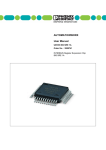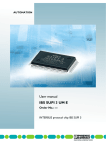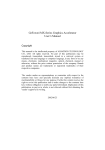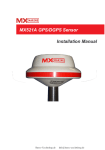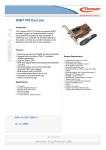Download Leica MX535 User's Manual
Transcript
MX535 UAIS Ship Borne Class A Transponder Unit Technical & Installation Manual WARNING: THIS EQUIPMENT COMPLIES WITH PART 80 OF THE FCC RULES. ANY CHANGES OR MODIFICATIONS NOT EXPRESSLY APPROVED BY THE MANUFACTURER COULD VOID THE USER’S AUTHORITY TO OPERATE THE EQUIPMENT. IMPORTANT NOTICE THE MX535 SYSTEM IS AN AID TO NAVIGATION. UNDER NO CIRCUMSTANCES SHOULD IT BE USED IN LIEU OF AUTHORIZED GOVERNMENT CHARTS. ITS ACCURACY CAN BE AFFECTED BY MANY FACTORS SUCH AS EQUIPMENT DEFECTS, ENVIRONMENTAL CONDITIONS, OR IMPROPER OPERATION. THE USER IS RESPONSIBLE FOR SAFE NAVIGATION OF THE VESSEL. THIS INCLUDES CONSULTING AUTHORIZED GOVERNMENT CHARTS AND EXERCISING COMMON PRUDENCE AND NAVIGATIONAL JUDGEMENT AT ALL TIMES. Part No. 3508 102 70870 Rev. D MX-Marine January, 2005 By: TCD This document is the property of MX-Marine. It must not be reproduced or otherwise made available to any third party without our permission in writing. Alterations due to technical progress are reserved. MX Marine (USA) 23868 Hawthorne Blvd., Suite 201 Torrance, CA 90505 USA +1 310 791 8213 (Telephone) +1 310 791 6108 (Fax) MX Marine (UK) Ocean Quay Southampton SO14 5QY United Kingdom +44(2380) 33 99 22 (Telephone) +44(2380) 33 03 45 (Fax) www.mx-marine.com www.mx-marine.com How To Contact Us? Contact your local MX-Marine, Leica dealer for: • Installation, Service, & Technical Support • Sales of Accessories • Hardware and Software Upgrades Unlike many other consumer electronics industries which only sell consumer electronic devices, your marine dealer is often your best advisor for installation and service of your new AIS unit. MX-Marine, Leica strongly encourages you to utilize the knowledge and experience of your sales and service dealer. Should you need to contact us directly for new sales, upgrades, repair service, or technical support, we can be reached at the following: International: MX-Marine (USA) 23868 Hawthorne Blvd., Suite 201 Torrance, California 90505 USA +1 310 791 8213 (Telephone) +1 310 791 6108 (Fax) In Europe: MX Marine (UK) Ocean Quay Southampton SO14 5QY United Kingdom +44(2380) 33 99 22 (Telephone) +44(2380) 33 03 45 (Fax) Email: [email protected] [email protected] www.mx-marine.com Table of Contents 1 1.1 1.2 1.3 2 2.1 2.2 2.3 2.4 3 General .............................................................................................................................................1 Software Releases ........................................................................................................................1 General Recommendations for Installation, Maintenance and Repair Work .........................1 Safety Warnings ............................................................................................................................1 Overview ..........................................................................................................................................3 Supplied Equipment ......................................................................................................................3 Compatibility with Other Systems ..............................................................................................3 MX535 Transponder with MX420 CDU ........................................................................................4 MX535 Transponder Overview ....................................................................................................5 Installation ......................................................................................................................................6 3.1 General Requirements .................................................................................................................6 3.2 3.2.1 3.2.2 3.2.3 3.3 3.3.1 3.3.2 3.3.2.1 3.3.2.2 3.3.2.3 3.3.2.4 3.3.2.5 3.3.2.6 3.4 3.4.1 3.4.2 3.4.3 3.4.4 3.5 3.5.1 3.5.2 3.6 3.6.1 3.6.2 3.6.3 3.6.4 3.6.5 3.6.6 Installation Overview Survey .............................................................................................................................................6 Step-by-step Installation Procedure.......................................................................................... .....6 MX535 Connection Diagram ...........................................................................................................7 Components and Interfaces ........................................................................................................7 General Interface Description .........................................................................................................8 Interface NMEA Description ...........................................................................................................9 Sensor – Interface CH1, CH2, CH3 ................................................................................................9 ECDIS – Presentation Interface CH4 .............................................................................................9 PILOT Port CH5 ............................................................................................................................10 LONG RANGE CH8 ......................................................................................................................10 DGPS – DGNSS CH9 ...................................................................................................................11 ALARM CIRCUIT .........................................................................................................................11 Sensor Interface Definitions .......................................................................................................11 Sensor Notes .................................................................................................................................12 Sensor Hardware Installation.........................................................................................................13 Priority Handling of Sensor Sentence ...........................................................................................14 Pin-Description AIS Cable/Socket 50-Pins ...................................................................................19 Installation of VHF/GPS Antennas .............................................................................................21 VHF Antenna Installation ..............................................................................................................21 GNSS Antenna Installation ...........................................................................................................22 Specific Recommendations........................................................................................................23 Recommendations Concerning AIS Systems ...............................................................................23 Recommendations Concerning Installation of Transponder Unit .................................................23 Recommendations Concerning Installation of VHF Antenna .......................................................23 Recommendations Concerning Installation of GPS Antenna .......................................................23 Recommendations Concerning Redundancy ................................................................................24 Emergency Power Source ............................................................................................................24 4 4.1 5 5.1 5.2 5.3 5.3.1 5.4 6 6.1 6.1.1 Technical Data ............................................................................................................................25 Technical Information ................................................................................................................25 Setting-to-Work/Configuration .............................................................................................27 Setting-to-Work ...........................................................................................................................27 Software Versions ......................................................................................................................27 Configuration ..............................................................................................................................27 Configuration with MX420/MKD CDU ...........................................................................................27 Testing .........................................................................................................................................27 Repair/Maintenance ..................................................................................................................28 Trouble Shooting ........................................................................................................................28 Hints ..............................................................................................................................................28 7 Fault Code List ............................................................................................................................31 8 Cabling Documents ..................................................................................................................33 9 PRODUCT WARRANTY ...........................................................................................................35 www.mx-marine.com List of Abbreviations This list also contains abbreviations which are not used in this manual but in additional documentation. A AIS Universal shipborne Automatic Identification System B BIIT Built-In Integrity Test C COG CDU D DCU DSC Course Over Ground Control and Display Unit (MX420/MKD) Display and Control Unit (MX420/MKD) Digital Selective Call E ECDIS Electronic Chart Display and Information System H HDG Heading L LR Long Range M MAC MKD MMSI Medium Access Control Minimum Keyboard and Display Maritime Mobile Service Identity P PDP PP Primary Display Port (Presentation Interface) Pilot Port (Auxiliary Display Port) S SOG Speed Over Ground U UAIS Universal shipborne AIS V VDL VDM VDO VHF Data Link Serial output message containing VDL information (IEC 61162-1) Serial output message containing VDL information (IEC 61162-1) (from own ship) MX535 AIS Transponder Unit Technical & Installation Manual ____________________________________________________________________________________________ 1 General This Technical & Installation Manual is the installation manual for the MX535 AIS Transponder. It also contains information about the antennas (GPS and VHF) and cabling used by the MX535. Related Documents MX420 Operator’s Manual (P/N 3508 102 70040) 1.1 Software Releases MX535 This manual is valid for all software versions of the MX535. See also Section 5.2. MX420 The CDU must have the program version V2.0(841) or later to work properly with the MX535 (NAUTICAST) AIS transponder. 1.2 General Recommendations for Installation, Maintenance and Repair Work MX-Marine Company gives advice and recommendations for the arrangement of MX-Marine equipment and the installation sites. A prerequisite is that the necessary drawings of the ship should be made available in good time. The advice and recommendations contained in this manual are given on the basis of our up-to-date practical experience and to the best of our knowledge. However, they are given without any commitment. As far as is permissible, any liability on the part of MX-Marine for resulting damage is expressly ruled out, regardless of whether the damage is of a direct or indirect nature. Unusual shipbuilding shapes, additions or superstructures as well as environmental influences can impair the functioning of the equipment. We are, of course, willing to help the customer with optimising solutions subject to suitable commercial arrangements. The customer is responsible for ensuring that the MX-Marine equipment is installed properly according to our instructions and in compliance with the regulations issued by the relevant classification society and national authorities. 1.3 Safety Warnings WARNING This unit contains electrostatic sensitive devices. Observe precautions for handling. The discharge of electrostatic energy into a semiconductor can destroy the semiconductor or change its properties. Before a unit’s housing is opened to remove or touch a board, the service equipment, Order No. 586-5011, must be used. www.MX Marine.com 1 MX535 UAIS Transponder Unit Technical & Installation Manual _______________________________________________________________________________________ 1. The mat must be positioned at the workplace. 2. The potential equalization cable must be connected to the snap fastener and the clamp to a suitable protective earth contact. The cable contains a 1 MΩ resistor, which must not be removed. 3. The wristband must be put on. When the spiral cable is connected to the snap fastener, the discharge line is established. 4. Thoroughly grounded soldering, measurement and test tools must be used. If these tools are supplied with power from the 110 or 230 VAC mains, a fault current plug must protect this supply. Boards and units that contain ESD-endangered semiconductors are marked with the symbol shown above. All assisting persons who might come into contact with the endangered boards must also use the ESD equipment. DANGER It is not permissible to connect the ship’s mains to the system before setting-to-work by a qualified technician. The mains must be switched off (e.g. by means of a common isolating switch or a circuit breaker) in the ship’s supply or the mains cable must be disconnected until setting-to-work takes place. If a synchro is connected via an appropriate interface, dangerous voltages might be present, even although all supplies to the system are switched off. Capacitors and tubes can store dangerous voltages for several hours, even when they have been disconnected from the supply voltage. WARNING Pay attention to the regulations for the prevention of accidents. DANGER Even when the system is switched off, there might be a dangerous voltage present on exposed contacts. Therefore, before a unit is opened, it must be ensured that the electrical supply to all units is, and remains, disconnected from the ship’s mains. www.mx-marine.com 2 MX535 AIS Transponder Unit Technical & Installation Manual ____________________________________________________________________________________________ 2 Overview The MX535 is an AIS Transponder Unit, which receives data from other vessels by means of a VHF radio and sends these data to the MX420 Control and Display Unit (CDU) or the ECDIS. In the opposite direction, the AIS receives data from the external GPS system and the ship’s sensors and transmit these data by means of the VHF radio. Access to these data and access to the VHF radio for a pilot is prepared by means of an additional pilot port. The AIS has a Long-Range (LR) Port to connect a long-distance communication system, for instance a satellite communication system. In this way, the AIS can be called to send the ship’s data. These data are sent back via the long-range port to the questioner. 2.1 Supplied Equipment The following items are supplied with the MX535 Kit: Description Part Number MX535 AIS system comprising: MX535 Transponder Mounting Kit JB-50 Junction Box (optional) AIS Cable GPS/VHF Cable MX535 N(m) / RG214(crimp) MX535 Technical & Installation Manual 9525 200 80800 3508 102 70800 3508 102 70820 3508 102 70830 3508 102 70840 3508 102 70850 3508 102 70860 3508 102 70870 2.2 Compatibility with Other Systems The MX535 AIS transponder can be used with the following systems: MX420/AIS Control and Display Unit (CDU) Version V2.0(841) or later, or MX420 MKD with Program Version V2.0(841) or later IMO compliant ECDIS systems (only listening). It is not allowed to transmit data (e.g. VSD, SSD) into the MX535 via an ECDIS. It is also possible to use the MX535 within systems from other manufacturers, which support the IEC-defined interfaces. www.MX Marine.com 3 MX535 UAIS Transponder Unit Technical & Installation Manual ____________________________________________________________________________________________ 2.3 UAIS MX535 with MX420/AIS or MKD CDU GPS ANT. MX-MARINE SMART DGPS ANTENNA (NOT USED FOR MKD). JB-50 Junction Box (optional) VHF ANT. MX535 TRANSPONDER MX420/AIS OR MX420/MKD EXT. GPS CH 4 MX420/MX535 communication CH 1 CH 3 CH 8 CH 5 CH 9 Ch2 (GLL,DTM,VTG) Non-MX535 ECDIS/ARPA Listener GYRO ROT LONG RANGE RTCM SC 104 unit Figure 2.1 - MX535 AIS Transponder with MX420/AIS or MKD CDU The Display and Control Unit MX420/AIS is used to configure and operate the MX535 transponder unit. In this case, the MX420/AIS or MKD can just be a display. For further information refer to the Operator and Installation Manual of the MX420 Control and Display Unit (CDU). www.mx-marine.com 4 MX535 UAIS Transponder Unit Technical & Installation Manual ____________________________________________________________________________________________ 2.4 MX535 Transponder Overview Figure 2.2 – MX535 UAIS Transponder The aluminum housing shown in Fig. 2.2 contains a single Transponder Unit, which consists of the: Controller Interfaces VHF transmitter VHF receivers GPS receiver. The housing has two cable connectors (GPS/VHF Interface Cable and AIS Cable) for the connection of: GPS antenna VHF antenna AIS www.mx-marine.com 5 MX535 UAIS Transponder Unit Technical & Installation Manual ____________________________________________________________________________________________ 3 Installation . 3.1 General Requirements Please note that international conventions, regulations, instructions and guidelines have to be adhered to when installing the MX535 AIS transponder. The following points must be observed before installation can commence: • • • • • • Trained service personnel must undertake the installation. The MX535 Transponder must be fitted in a suitable place on the bridge. The VHF and GPS Antennas must be installed in a suitable position, where excellent reception conditions apply (refer to Section 3.5, Installation of VHF and GPS antennas – page 21) All available interfaces must be installed. The vessels power supply must suffice, and the GMDSS power supply has to be used. Installation of the pilot plug in conning position (close to the pilot working place). 3.2 Installation Overview 3.2.1 Survey AIS is considered part of the ship’s radio station and is surveyed together with radio installation. Surveys on SOLAS Convention ships should be carried out in accordance with the rules laid down in IMO Res. A 746(18) "Survey Guidelines under the harmonised system of survey and certification" (R) 8, and "Protocol of 1988 relating to the International Convention for the Safety of Life at Sea, 1974." The MX535 system consists of the MX535 Transponder Unit, MX420 CDU, VHF Antenna, Backup GPS Antenna, MX521(MX525) Smart Antenna, and associated cable. 3.2.2 Step-by-Step Installation Procedure • Use the VHF adapter cable (P/N 3508 102 70850) together with the VHF plug and TNC plug to connect the VHF and GPS antenna cables as well as the antennas. • The sensors, ECDIS, PC, pilot case, long range devices and auxiliary displays can be connected to the MX535 transponder cabinet by the AIS cable or JB-50 Junction Box (optional). The device is driven by a 24V DC 7A supply, which is connected to the power terminal at the JB-50 Junction Box (optional). The AIS should be connected to an emergency power source. A battery capacity calculation together with GMDSSequipment is needed! After performing these steps, the MX535 transponder automatically starts operation. • The MX535 transponder has a ground terminal, which has to be connected to ship ground. www.mx-marine.com 6 MX535 UAIS Transponder Unit Technical & Installation Manual ___________________________________________________________________________________________________________________ 3.2.3 MX535 Connection Diagram MX-MARINE SMART DGPS ANTENNA (NOT USED FOR MKD). MX420/AIS OR MX420/MKD EXT. GPS Non-MX535 ECDIS/ARPA Listener MX420/MX535 communication Figure 2.3 – MX535 Connection Diagram Note: The MX535 JB-50 Junction Box (optional) includes a fuse of 6.3A. If it is not used, then the unit has to be protected against high current by an external slow blow fuse of 6.3A. 3.3 Components and Interfaces The diagram below illustrates which devices can be connected to the MX535 Transponder. For a detailed description of sensor connecting e.g. an existing Gyro to MX535, refer to Section 3.4. (2.3) “Sensor Installation” on page 12-13. www.mx-marine.com 7 MX535 UAIS Transponder Unit Technical & Installation Manual ___________________________________________________________________________________________________________________ GPS ANT. MX-MARINE SMART DGPS ANTENNA (NOT USED FOR MKD). JB-50 Junction Box (optional) VHF ANT. MX535 TRANSPONDER MX420/AIS OR MX420/MKD EXT. GPS CH 4 MX420/MX535 communication CH 1 CH 3 CH 8 CH 5 CH 9 Ch2 (GLL,DTM,VTG) Non-MX535 ECDIS/ARPA Listener GYRO ROT LONG RANGE RTCM SC 104 unit Figure 2.4 – Devices that can be connected to MX535 3.3.1 General Interface Description Interface Sensor 1 Sensor 2 Sensor 3 ECDIS PILOT LONG RANGE DGPS (RTCM SC104) ALARM CIRCUIT Designation CH 1 CH 2 CH 3 CH 4 CH 5 CH 8 CH 9 CH 10 Speed 4800 or 38400 bps 4800 or 38400 bps 4800 or 38400 bps 38400bps 38400bps 38400bps 9600bps Direction Input Input Input Input/Output Input/Output Input/Output Input Dry relay contact (power off and alarm state closed) www.mx-marine.com 8 MX535 UAIS Transponder Unit Technical & Installation Manual ___________________________________________________________________________________________________________________ 3.3.2 Interface NMEA Description 3.3.2.1 External Sensors - Interface on CH1, CH2, CH3 The MX535 AIS transponder requires connection to various sensor devices. MX535(AIS) and MX420/AIS or MKD (CDU) together offer the following configuration options: • • • • Set up data speed 4800 or 38400 baud. Monitor the connected sensor inputs for each sensor channel. Analyze the information received from the connected sensor devices. Configuration of various NMEA protocols. The individual options may be repeated until the required configuration for the connected sensor devices is achieved. 3.3.2.2 ECDIS – Presentation Interface CH 4 Direction Used Fields ABK ACA ACK AIR ALR ABM BBM Sentence Formatters UAIS Addressed and binary broadcast acknowledgement AIS Channel assignment message Acknowledge Alarm UAIS Interrogation Request Set Alarm State UAIS Addressed binary and safety related message UAIS Broadcast Binary Message Out In / Out In In Out In In All fields are provided for Input and Output. DSC DSE DSI DSR LRI LRF SSD TXT VSD VDM VDO Digital Selective Calling Information Expanded Digital Selective Calling DSC Transponder Initialize DSC Transponder Response UAIS Long-Range Interrogation UAIS Long-Range Function Station Static Data Text Transmission Voyage Static Data UAIS VHF Data-link Message UAIS VHF Data-link Own-vessel report Out Out Out Out Out Out In Out In Out Out For further information please refer to IEC 61993-2 / NMEA 0183 HS V3.0 for detailed field information. www.mx-marine.com 9 MX535 UAIS Transponder Unit Technical & Installation Manual ___________________________________________________________________________________________________________________ 3.3.2.3 PILOT Port CH 5 The used sentence formatters for the pilot plug are the same as those listed for the ECDIS port (CH 4). Note: A pilot input/output port is part of an AIS Class A installation. A plug connected to this port should be installed on the bridge near the pilot’s operating position, so that a pilot can connect a Personal Pilot Unit (PPU) if required. Also, a power connector for the pilot unit should be available nearby. The pilot plug should be configured as follows: (Refer to SUB-COMMITTEE ON SAFETY OF NAVIGATION NAV48/18 2.4.2002) AMP/Receptacle (Square Flanged (-1) or Free-Hanging (-2)), Shell size 11, 9-pin, Std. Sex 206486-1/2 or equivalent with the following connections: • • • • • Tx A (out-) is connected to Pin 1 Tx B (out+) is connected to Pin 4 Rx A (in-) is connected to Pin 5 Rx B (in+) is connected to Pin 6 Shield is connected to Pin 9 3.3.2.4 LONG RANGE CH 8 The AIS long range function requires a compatible long range communication system (e.g. Inmarsat-C or MF/HF radio as part of GMDSS). This connection is required in order to activate the long range function of the AIS. Its input/output port must meet the IEC 61162-2 requirements. LRI LRF LR1 LR2 LR3 Sentence Formatters UAIS Long Range Interrogation UAIS Long-Range Function UAIS Long-Range Reply Sentence l UAIS Long-Range Reply Sentence 2 UAIS Long-Range Reply Sentence 3 Direction Input Input / Output Output Output Output Field Information: All fields are provided for input and output. For further information please refer to IEC 61993-2 / NMEA 0183 HS V3.0 for detailed field information. www.mx-marine.com 10 MX535 UAIS Transponder Unit Technical & Installation Manual ___________________________________________________________________________________________________________________ 3.3.2.5 DGPS – DGNSS Channel 9 Field / Protocol information: All fields are provided for further information; please refer to ITU-R M.823-2 / RTCM SC 104 for detailed field information. 3.3.2.6 ALARM CIRCUIT The AIS requires that an alarm output (relay) must be connected to an audible alarm device (MX420/AIS or MKD CDU) or the ship’s alarm system, if available. 3.4 Sensor Interface Definitions All interface ports of MX535 Transponder comply with IEC-61162-1 / -2 and NMEA-0183 HS 3.0 specifications (aligned to RS422 parameters). Talker drive circuits The maximum output current is Imax = 50mA on each port. The drive circuit meets the requirements of ITU-T V.11. Listener Receiver Circuits Multiple listeners may be connected to a single talker. Optional termination resistors (120Ohm) for the input lines are provided in the JB-50 Junction Box (optional). The input terminals A, B and C are electrically isolated from the remaining electronics of the listening device. The input impedance is 30kOhm between A and B lines, disregarding the connection of termination resistors. The minimum input voltage is ±0.3V. The listener's receiver circuit complies with ITU-T V.11. Electrical isolation There are no direct electrical connections between the signal lines A and B. The signal ground C must not be connected to the ship main ground or power line! This isolation is in accordance with IEC 60945. Maximum voltage on the bus The maximum applied voltage between signal lines A and B and between either line and ground C is in accordance with ITU-T V.11. For protection against incorrect wiring and for unintended connection to older TALKER models, all receiver circuit devices are capable of withstanding 15 V between both lines and signal ground for an indefinite period. Data transmission Data is transmitted in serial asynchronous form in accordance with IEC 61162-1. The first bit is a start bit, and is followed by data bits, whereby the least significant bit is first. The following parameters are used: • • • Baud rate 4800 (bits/s) Data bits 8 (D7 = 0), parity none Stop bits 1. www.mx-marine.com 11 MX535 UAIS Transponder Unit Technical & Installation Manual ___________________________________________________________________________________________________________________ 3.4.1 Sensor Notes External Sensor The AIS has interfaces (configurable as IEC 61162-1 or 61162-2) for position, bottom track (BT) speed, heading and rate of turn (ROT) sensors. In general, sensors installed in compliance with other carriage requirements of SOLAS Chapter V should be connected to the AIS System.*1. The sensor information transmitted by AIS should be the same information being used for navigation of the ship. Interfacing problems might occur if the existing on board sensors do not have serial (IEC 61162) outputs. A converter is needed to translate the non-conforming data to IEC 61162 – sensor data. For Example, Nauticast Converter type NAUZ002 or Raytheon Nav Data Repeater 133-812. The fact that AIS is fitted on board a vessel does NOT entail the need to install additional sensors other that those stated in the carriage requirements. External GPS GNSS position sensors normally have IEC 61162 outputs suitable for direct AIS interfacing. However, it is important to note that: • The Geodetic Datum of the position data is transmitted by the sensor in WGS84 so that an IEC 61162 DTM sentence is configured. • The MX420/AIS or MKD is able to handle three reference points -- two external GPS antennas, and one internal GPS antenna. • External GPS antennas SHOULD NOT be connected directly to the MX535. External Heading A gyrocompass providing heading information (HDT) is a mandatory sensor input to the AIS. A converter unit (synchro or step-signal converter to NMEA 0183 v.3.0) for example Nauticast Converter type NAU-Z002 or Raytheon Nav Data Repeater 133-812 will be needed for AIS connection in the case that the ship’s gyrocompass does not provide IEC 61162 output. External Speed and Course If a bottom track (BT)log for speed over ground (SOG) is available, it may be connected. A converter (for example Raytheon converter type: 133-812) is needed if the BT-log does not provide IEC 61162 outputs External Rate of Turn Not all ships will carry a Rate-Of-Turn (ROT) indicator according to IMO A.526. However, if a rate-of-turn indicator is available and it includes an IEC 61162 interface, it should be connected to the AIS. If ROT information is not available from a ROT indicator, it may (optionally) be derived from heading information through: • The gyrocompass itself, • An external converter unit (see Heading), • The AIS itself (calculated ROT). www.mx-marine.com 12 MX535 UAIS Transponder Unit Technical & Installation Manual ___________________________________________________________________________________________________________________ 3.4.2 Sensor Hardware Installation Installation of an RS422 serial interface: In most cases, the output from a GPS is already being used by existing navigation equipment. It is possible to split an RS-422 output for two devices. If the signal becomes too low, then an NMEA splitter has to be used. Example for single talk multi-listener connection: Shields A B C (GND) Talker (e.g.: GPS) + IN G1 (or 2,3) - IN A B C (GND) Listener (other equipment) Each interface on the Transponder is a RS422 serial interface. The shield or ship main ground should not be connected with the signal ground (GND). www.mx-marine.com 13 MX535 UAIS Transponder Unit Technical & Installation Manual ___________________________________________________________________________________________________________________ 3.4.3 Priority Handling of Sensor Sentence The following table shows the priority handling of NMEA sentences. The sentences, which are treated with higher priority, are listed first. Positioning System Time of Position Latitude/Longitude Position accuracy Rate of Turn(ROT) Reference Datum Speed over Ground Heading RAIM Indicator Source Priority HIGH GNS GLL GGA RMC ROT DTM VBW VTG OSD RMC HDT OSD GBS LOW Supported NMEA-0183 Sentences DTM - Reference 1 2 3 4 5 6 7 8 9 | | | | | | | | | $--DTM,ccc,a,x.x,a,x.x,a,x.x,ccc*hh<CR><LF> Field Numbers: 1) Local datum code (W84,W72,S85,P90,999-user defined, IHO datum code) 2) Local datum subdivision code 3) latitude offset, minutes 4) N or S (North or South) 5) longitude offset, minutes 6) E or W (East or West) 7) altitude offset, meters 8) Reference datum code ((W84,W72,S85,P90) 9) CRC Used Fields: 1,8 1: Local datum code 8: Reference datum code www.mx-marine.com 14 MX535 UAIS Transponder Unit Technical & Installation Manual ___________________________________________________________________________________________________________________ GGA - Positioning System Fix Data Time, Position and fix related data form GPS receiver. 11 1 2 3 4 5 6 7 8 9 10 | 12 13 14 15 | | | | | | | | | | | | | | | $--GGA,hhmmss.ss,llll.ll,a,yyyyy.yy,a,x,xx,x.x,x.x,M,x.x,M,x.x,xxxx*hh Field Numbers: 1) UTC 2) Latitude 3) N or S (North or South) 4) Longitude 5) E or W (East or West) 6) GPS Quality Indicator, 0 - fix not available, 1 - GPS fix, 2 - Differential GPS fix 7) Number of satellites in view, 00 - 12 8) Horizontal Dilution of precision 9) Antenna Altitude above/below mean-sea-level (geoid) 10) Units of antenna altitude, meters 11) Geoidal separation, the difference between the WGS-84 earth ellipsoid and mean-sea-level (geoid), \-\ means mean-sea-level below ellipsoid 12) Units of geoidal separation, meters 13) Age of differential GPS data, time in seconds since last SC104 type 1 or 9 update, null field when DGPS is not used 14) Differential reference station ID, 0000-1023 15) CRC Used Fields: 1,2,3,4,5,6,7 1:UTC 2:Lat 3:LaInd 4:Lon 5:LoInd 6:Acc 7:Sat GLL - Position - Latitude/Longitude 1 2 3 4 5 6 7 8 | | | | | | | | $--GLL,llll.ll,a,yyyyy.yy,a,hhmmss.ss,A,a*hh<CR><LF> Field Numbers: 1) Latitude 2) N or S (North or South) 3) Longitude 4) E or W (East or West) 5) Universal Time Coordinated (UTC) 6) Status A - Data Valid, V - Data Invalid 7) Mode indicator 8) CRC Used Fields: 1,2,3,4,5,6,7 1:Lat 2:LaInd 3:Lon 4:LoInd 5:UTC 6:Valid 7:Acc www.mx-marine.com 15 MX535 UAIS Transponder Unit Technical & Installation Manual ___________________________________________________________________________________________________________________ GNS - Fix Data 1 2 3 4 5 6 7 8 9 10 11 12 13 | | | | | | | | | | | | | $--GNS,hhmmss.ss,llll.ll,a,yyyyy.yy,a,c--c,xx,x.x,x.x,x.x,x.x,x.x*hh Field Numbers: 1) UTC 2) Latitude 3) N or S (North or South) 4) Longitude 5) E or W (East or West) 6) Mode indicator 7) Total number of satelites in use,00-99 8) HDROP 9) Antenna altitude, meters, re:mean-sea-level(geoid) 10) Goeidal separation meters 11) Age of diferential data 12) Differential reference station ID 13) CRC Used Fields: 1,2,3,4,5,6,7 1:UTC 2:Lat 3:LaInd 4:Lon 5:LoInd 6:Acc 7:Sat RMC - Minimum Navigation Information 12 1 2 3 4 5 6 7 8 9 10 11| 13 | | | | | | | | | | | | | $--RMC,hhmmss.ss,A,llll.ll,a,yyyyy.yy,a,x.x,x.x,ddmmyy,x.x,a,a*hh<CR><LF> Field Numbers: 1) UTC Time 2) Status, V = Navigation receiver warning 3) Latitude 4) N or S 5) Longitude 6) E or W 7) Speed over ground, knots 8) Course over Ground, degrees true 9) Date, ddmmyy 10) Magnetic Variation, degrees 11) E or W 12) Mode Indicator 13) CRC Used Fields: 1,2,3,4,5,6,7,8,9,10,11,12 1:UTC 2:Valid 3:Lat 4:LaInd 5:Lon 6:LoInd 7:SOG 8:COG 9:Date 10:MagV 11:MagIn 12:Acc www.mx-marine.com 16 MX535 UAIS Transponder Unit Technical & Installation Manual ___________________________________________________________________________________________________________________ VBW - Ground/Water Speed 1 2 3 4 5 6 7 | | | | | | | $--VBW,x.x,x.x,A,x.x,x.x,A*hh<CR><LF> Field Numbers: Used Fields: 1,5,6,7,8,9 1:COG 5:SOG 6:SOGIn 7:SOG 8:SOGIn 9:Valid OSD - Ship Data 1 2 3 4 5 6 7 8 9 10 | | | | | | | | | | $--OSD,x.x,A,x.x,a,x.x,a,x.x,x.x,a*hh<CR><LF> Field Numbers: 1) Heading, degrees true 2) Status, A = Data Valid 3) Vessel Course, degrees True 4) Course Reference 5) Vessel Speed 6) Speed Reference 7) Vessel Set, degrees True 8) Vessel drift (speed) 9) Speed Units 10) CRC Used Fields: 1,2,3,4,5,6,9 1:HDT 2:HDTVal 3:COG 5:SOG 6:SOGRef 9:SOGInd 4:COGRef HDT – True Heading 1 2 3 | | | $--HDT,x.x,T*hh<CR><LF> Field Numbers: 1) Heading Degrees, true 2) T = True 3) CRC Used Fields: 1,2 1:HDT 2:HDTRu ROT – Rate of Turn 1 2 3 | | | $--ROT,x.x,A*hh<CR><LF> Field Numbers: 1) Rate Of Turn, degrees per minute, \-\ means bow turns to port 2) Status, A means data is valid 3) CRC www.mx-marine.com 17 MX535 UAIS Transponder Unit Technical & Installation Manual ___________________________________________________________________________________________________________________ Used Fields: 1,2 1:ROT 2:Valid Versions of NMEA Sentences RMC v2.30 - $GPRMC,122500.00,A,5330.1234,N,01001.2345,E,11.2,352.2,120202,2.0,E,A v2.20 - $GPRMC,122500.00,A,5330.1234,N,01001.2345,E,11.2,352.2,120202,2.0,E GLL v2.30 - $GPGLL,5330.1234,N,01001.2345,E,141800.00,A,A v2.00 - $GPGLL,5330.1234,N,01001.2345,E,141800.00,A v1.50 - $GPGLL,5330.1234,N,01001.2345,E GGA v2.00 - $GPGGA,092854,5330.1234,N,01001.2345,E,1,3,1.2,65.2,M,45.1,M,, v1.50 - $GPGGA,092854,5330.1234,N,01001.2345,E,1,3,1.2,65.2,M,45.1,M VBW v2.30 - $VDVBW,11.00,01.00,A,12.00,02.00,A,,V,,V v2.20 - $VDVBW,11.00,01.00,A,12.00,02.00,A VTG v2.30 - $GPVTG,350.0,T,,M,10.0,N,,K,A v2.20 - $GPVTG,350.0,T,,M,10.0,N,,K OSD v2.30 - $INOSD,359.9,A,5.2,B,12.6,B,150.0,1.2,N v2.20 - $INOSD,359.9,A,5.2,B,12.6,B,150.0 www.mx-marine.com 18 MX535 UAIS Transponder Unit Technical & Installation Manual ___________________________________________________________________________________________________________________ 3.4.4 TxA TxB RxA RxB Pin-Description AIS-Cable / Socket 50-Pins out – out + in – in + AIS Cable/Socket ( Sub-D 50 Plug ) 1 CH5_out+ 2 CH5_out- 3 18 Ch4_out+ 19 CH4_out- 20 CH4_gnd CH5_gnd 4 CH5_in+ 5 CH5_in- 6 CH6_Vin 7 CH6_gnd 21 CH4_in+ 22 CH4_in- 23 CH8_in+ 24 CH8_in- 25 CH8_gnd 8 9 10 11 CH1_in+ 13 CH2_in- 15 16 CH8_in+ 27 CH8_in- 28 Spare CH1_gnd 12 14 26 CH1_in- 29 CH3_in- 30 CH3_gnd 31 CH3_in+ 32 Vin_gnd 33 Vin+ (24V) 34 Spare 35 Spare 36 Spare 37 Spare 38 Spare 39 CH9_gnd 40 CH9_out- 41 CH9_in- 42 CH9_in+ 43 CH9_out+ 44 Spare 45 Spare 46 CH2_gnd 47 CH2_in+ Vin+ (24V) 48 Vin_gnd 49 Vin_gnd 50 Spare 17 Vin+ (24V) CH1 Sensor CH4 MX420/AIS or MKD CH8 Long Range CH2 Sensor CH5 aux. Display CH9 DGNSS CH3 Sensor CH6 opt. 61162-3 Spare Do not use AIS Plug and Socket Black BK White WH Red RD Green GN Brown BR Blue BL Orange OR Yellow YL Violet VI Gray SL(Slate) Pink PK www.mx-marine.com 19 MX535 UAIS Transponder Unit Technical & Installation Manual ___________________________________________________________________________________________________________________ Pin-Description AIS-Connector: AIS -Cable Sub-D 50 Plug Note: TxA TxB RxA RxB out – out + in – in + 16 17 33 48 49 32 + 24 VDC/max 5A + 24 VDC + 24 VDC 0 V 0 V 0 V rd rd rd bl bl bl DGPS Long Range Pilot Port MX420/AIS or MKD Channel 1,2,3 AIS-Cable Open CH1_in+ CH1_inCH1_gnd CH2_gnd CH2_in+ CH2_inCH3_in+ CH3_inCH3_gnd CH4_gnd CH4_in+ CH4_inCH4_out+ CH4_outCH5_in+ CH5_inCH5_out+ CH5_outCH5_gnd CH8_gnd CH8_in+ CH8_inCH8_out+ CH8_outCH9_in+ CH9_inCH9_out+ CH9_outCH9_gnd Spare_gnd Spare_in+ Spare_inSpare_out+ Spare_out- 12 10 11 14 15 13 31 29 30 20 21 22 18 19 4 5 1 2 3 25 26 27 23 24 42 41 43 40 39 36 35 34 38 37 9 8 6 7 46 47 SPEED LOG VBW e.g. GPS GLL, VTG, DTM e.g. GYRO HDT,ROT e.g MX420/AIS CDU 6 5 4 1 AMP Pilot Plug NC e.g. Inmarsat unit RTCM SC104 unit NC NC NC Service unit Alarm unit 1 2 3 7 5 6 9 10 11 17 13 14 15 16 19 20 21 22 23 29 25 26 27 28 31 32 33 34 35 41 37 38 39 40 43 44 45 46 49 50 WH/BK BR/BK SL/GN YL/SL PK/GN YL/PK GN/BL YL/BL GN/RD YL/RD GN/BK YL/BK SL/BL PK/BL SL/RD PK/RD SL/BK PK/BK WH/SL SL/BR WH/PK PK/BR WH/BL BR/BL WH/YL YL/BR WH/GN BR/GN SL/PK RD/BL SL PK GN YL WH BR RD BL BK VI www.mx-marine.com 20 MX535 UAIS Transponder Unit Technical & Installation Manual ___________________________________________________________________________________________________________________ 3.5 Installation of VHF / GPS Antennas Interference to the Ship’s VHF Radiotelephone The AIS ship borne equipment, like any other ship borne transceiver operating in the VHF maritime band, may cause interference to a ship’s VHF radiotelephone. Because AIS is a digital system, this interference may occur as a periodic (e.g. every 20 seconds) soft clicking sound on the ship’s radiotelephone. This may become more noticeable if the VHF radiotelephone antenna is located close to the AIS VHF antenna, and when the radiotelephone is operating on channels near the AIS operating channels (e.g. channels 27, 28 and 86). Attention should be paid to the location and installation of the various antennas, in order to support the antenna characteristics in the best possible way. 3.5.1 VHF Antenna Installation Antenna Location Location of the mandatory AIS VHF-antenna should be carefully considered. Digital communication is more sensitive than analogue/voice communication to interference created by reflections caused by obstructions such as masts and booms. It may be necessary to relocate the VHF radiotelephone antenna to minimize interference effects. To minimise interference effects, the following guidelines apply: The AIS VHF antenna should have omni directional vertical polarisation providing 3 to 5 dB gain. The AIS VHF antenna should be placed in an elevated position, as free standing as possible, with a minimum of 2 metres in horizontal direction from constructions made of conductive materials. The antenna should not be installed close to any large vertical obstruction. The AIS VHF antenna should have a visible sky of 360°. The AIS VHF antenna should be installed at least 3 meters away from interfering high-power energy sources such as radar and other transmitting radio antennas, and out of the way of the transmitting beam. There should not be more than one antenna on each level. The AIS VHF antenna should be mounted directly above or below the ship’s primary VHF radiotelephone antenna, with no horizontal separation and a minimum of 2 metres vertical separation. If it is located on the same level as other antennas, the distance apart should measure at least 10 metres. Cabling The cable should be kept as short as possible to minimise attenuation of the signal. Double shielded coaxial cables equal to or better than RG214 are recommended. RG214 at VHF attenuation per meter of app. 0.07 dB/m (45m = 3.15db) VHF AIS frequency app. 162MHz All outdoor connectors on the coaxial cables should be fitted with preventive isolation, such as shrink-stocking with silicone to protect the antenna cable against water penetration. Coaxial cables should be installed in separate signal cable channels/tubes, and at least 10 cm away from any power supply cables. Crossing of cables should take place at right angles (90°). Coaxial cables should not be exposed to sharp bends, which may lead to changes to the characteristic impedance of the cable. The minimum bend radius should be 5 times the cables outside diameter. Grounding Coaxial down-leads must be used for all receiving antennas, and the coaxial screen should be connected to the ground at one end. www.mx-marine.com 21 MX535 UAIS Transponder Unit Technical & Installation Manual ___________________________________________________________________________________________________________________ 3.5.2 GNSS Antenna Installation Antenna Location The GNSS antenna must be installed where it has a clear view of the sky, so that it accesses the horizon freely through 360°, with a vertical observation of 5 to 90 degrees above the horizon. Small diameter obstructions, such as masts and booms, do not seriously impair signal reception, but such objects must not eclipse more than a few degrees of any given bearing. The antenna must be located at least three meters away from, and out of the transmitting beam of high-power transmitters (S-Band Radar and/or Inmarsat systems). This includes the ship’s own AIS VHF antenna, if it is designed and installed separately. If a DGNSS system is included or connected to the AIS system, the installation of the antenna should be undertaken in accordance with IEC 61108-4, Edition 1. Cabling To achieve optimum performance, the gain of the antenna pre-amplifier should match the cable attenuation. The resulting installation gain (pre-amplifier gain - cable attenuation) should be within 0 to 10 dB. RG214 at GPS attenuation per meter of app. 0.35 dB/m (45m = 15.75dB) GPS frequency app. 1.2GHz The coaxial cable between the antenna and the AIS ship borne station connector should be routed directly, in order to reduce electromagnetic interference. The cable should not be installed close to high-power lines, such as radar or radio-transmitter lines, or near the AIS VHF antenna cable. A space of one meter or more is recommended in order to avoid degradation due to RF-coupling. Crossing of antenna cables should take place at 90 degrees, to minimise magnetic field coupling. Antenna Layout The position of the VHF und GNSS – antennas must be added to the existing antenna layout of the vessel. Power Supply The MX535 transponder must be supplied from the emergency power source. A further requirement is to connect AIS to the reserve power source of the GMDSS. A new battery capacity calculation must then be undertaken. Following documents are needed for the installation approval of the classification • • • • Antenna Layout (arrangement) Battery Calculation Connection / Block – Diagram with locations Type Approval Certificate www.mx-marine.com 22 MX535 UAIS Transponder Unit Technical & Installation Manual ___________________________________________________________________________________________________________________ 3.6 Specific Recommendations 3.6.1 Recommendations Concerning AIS Systems Recommendations for the installation of AIS systems are published in the IMO document NAV 48/WP.1. See this document for further information. The following sections also contain information, which has been taken from IMO NAV 48/WP.1. 3.6.2 Recommendations Concerning the Installation of the Transponder Unit The Transponder Unit should be mounted on a vertical bulkhead. A distance of at least 300 mm from other devices must be ensured above and below the housing for sufficient air circulation. 3.6.3 Recommendations Concerning the Installation of the VHF Antenna The digital signals of the AIS may occur as a periodic clicking sound on a ship’s radiotelephone. This effect may become stronger when the VHF antenna of the AIS is located near the VHF radiotelephone antenna and when the radiotelephone is operating on channels near the AIS operating channels (for example channels 27, 28, 86). The antenna should be placed in an elevated position that is as unobstructed as possible, with a minimum of 2 m in the horizontal direction from any structures made of conductive materials. The antenna should not be installed close to any large vertical obstruction. The objective for the VHF antenna is that it should "see" the horizon freely through 360°. The VHF antenna should be installed safely away from interfering high-power energy sources such as the radar scanner and other transmitting radio antennas, preferably at least 3 m away from and out of the transmitting beam. Ideally there should not be more than one antenna on the same level. The AIS VHF antenna should be mounted directly above or below the ship’s primary VHF radiotelephone antenna, with no horizontal separation and with a minimum of 2 m vertical separation. If it is located on the same level as other antennas, the distance apart should be at least 10 m. 3.6.4 Recommendations Concerning the Installation of the GPS Antenna The GPS antenna should be installed where it has a clear "view" of the sky. The objective is that it should "see" the horizon freely through 360° with a vertical observation sector of 5...90° above the horizon. Small diameter obstructions, such as masts and booms, do not seriously degrade signal reception, but such objects should not eclipse more than a few degrees of any given bearing. Locate the antenna at least 3 m away from and out of the transmitting beam of high-power transmitters (SBand radar and/or INMARSAT systems). This includes the ship’s own AIS VHF antenna. www.mx-marine.com 23 MX535 UAIS Transponder Unit Technical & Installation Manual ___________________________________________________________________________________________________________________ 3.6.5 Recommendations Concerning Redundancy If possible, the Transponder Unit should be supplied with the ship’s Position sensor data from two different sources, e.g. MX521 Smart DGPS antenna or the MX525 DGPS Sensor or other equivalent sensors). 3.6.6 Emergency Power Source It is recommended that an emergency power source such as a 24 VDC uninterruptible power supply should be used. See Section 7 for information about the power consumption of the Transponder Unit. www.mx-marine.com 24 MX535 UAIS Transponder Unit Technical & Installation Manual ____________________________________________________________________________________________ 4 Technical Data 4.1 Technical Information PHYSICAL Size in mm / inch (w) Size in mm / inch (h) Size in mm / inch (d) Weight Operating Temperature 201.26mm / 7.92inch 60mm / 2.36inch 281.26mm / 11.07inch 2490g / 5.50lb -15°C to +55°C / 5°F to 131°F POWER SUPPLY Supply Voltage (galvanic isolated) Input Current 24 V DC (-10% +30%) min.7 A (24V) INTERFACES Number of Data Ports IEC 61162-1/2 ITU-R M.823-2 Bitrate CH1 Sensor Input; (i.E.: GPS) CH2 Sensor Input; (i.E.: GYRO) CH3 Sensor Input; (i.E.: HDG) CH4 ECDIS Port (In- / Output) AIS targets, AIS messages CH5 Pilot Port (In- / Output) AIS targets, AIS messages CH8 Long Range Port (In- / Output) CH9 DGPS correction (In- / Output) (RTCM SC104) 3 Input / 4 I-O / 1 Output ( RS422 / NMEA 0183) ( RS422 / RTCM SC104) 4800 or 38400 bps 4800 or 38400 bps 4800 or 38400 bps in/ out 38400 bps in/out 38400 bps in/out 38400 bps in/out 9600 bps SPECIFIED STANDARDS IMO MSC.74(69) Annex 3 ITU-R M.1371 (Class A) IALA Techn.Clar. of ITU-R M.1371-1 (Ed.1.3) IEC 61993-2 (2002) IEC 61162-1 (2000) IEC 61162-2 (1998) IEC 61162-3 ITU-R M.823-2 IEC 61108-1 (1996) IEC 60 945 (1996) ITU-R M.825-3 ITU-R M.1084-3 VHF Frequency Range Channel Spacing Number of RF Channels Number of AIS Receivers Number of DSC Receivers Frequency Error VHF TRANSMITTER Output Power Receive to Transmit Switching Time Transmit release time Automatic shutdown Channel switching time Attack Time NMEA 0183-3 NMEA 0183-3 NMEA 2000 156 MHz - 162MHz 12.5 or 25kHz 3 Receiv. / 1 Transm. 2 1 +/- 2.5ppm 2 Watt to 12.5 Watt (adjustable) < 1ms < 1ms 1 sec. < 25ms < 1ms www.mx-marine.com 25 MX535 UAIS Transponder Unit Technical & Installation Manual ____________________________________________________________________________________________ BUILT IN GPS Receiver Architecture Tracking Capability Accuracy Horizontal Accuracy Vertical GPS Antenna Connector DGPS Accuracy *) depends on SA 12 channel differential 12 satellites sim. 10m / 2drms * 15m / 2drms * TNC < 5m / 2drms GPS Solutions Beacon interoperability EGNOS interoperability WAAS interoperability OMNISTAR interoperability LongWave interoperability VHF interop. (DGPS over Msg.17) optional internal Beacon Receiver Combined GPS/DGPS Antenna Relay breaking capacity 30V DC 250V AC OPTIONAL INTERFACES Number of Data Ports RS232 Bitrate Simplex / Duplex Number of Data Ports IEC 61162-3 CAN (RS485) Bitrate VHF RECEIVER Max. Useable Sensitivity Co-channel Rejection Inter-modulation Rejection Spurious Response Rejection Blocking < -110dBm > -8dB (25kHz); > -12dBm (12.5kHz) > 70dB (25kHz); > 60dB (12.5kHz) > 65dB > 70dB > 84dB VHF MODEM Bitrate GMSK RF Baud Rate (DSC) Modulation 9600 bps 1200bps GMSK / FSK Adjacent Channel Selectivity 8° 8A up to 5 Up to 115000 bps Duplex 1 up to 1 Mbps www.mx-marine.com 26 MX535 UAIS Transponder Unit Technical & Installation Manual ____________________________________________________________________________________________ 5 Setting-to-Work/Configuration 5.1 Setting-to-Work The AIS Transponder Unit and antennas must be installed as described in Section 3.2.2, Page 6 (Step-by-Step Installation Procedure). For information about the dimensions see Section 4.2 (Technical Information). The cabling and connection must be performed corresponding to the Cabling Documents in Section 8. Depending on the system in which the AIS have to be integrated, the configuration has to be performed as described in section 5.3.1. 5.2 Software Version For AIS systems with an MX420/MKD: It must be verified that the MX420/MKD has the software version V2.0(841) or later. The software versions can be determined by means of the AUX7 screen of the MX420. 5.3 Configuration No adjustments have to be performed on the antennas. These components are ready for use. The AIS Transponder Unit is configured using the MX420/MKD. For information in detail, see the corresponding Technical Manuals and the Online Help of these systems. The following descriptions are an aid for the configuration of the AIS Transponder. NOTE: The system from which the AIS Transponder Unit has been configured and the AIS itself must be restarted after any change in the configuration. Otherwise these modifications may have no effect. The MX535 will maintain configuration data inside the transponder during power fails. In the event that the MX535 needs to be replaced, the configuration data from the MX420 must manually be resent to the MX535. Master/Slave After the power on from both units the MX420 (CDU) transmits the configuration data to the MX535 (Transponder). This is done with the SSD (ship static data) and the VSD (voyage ship data) sentences. The MX535 has an internal memory to store the data. The configuration data are valid until a new SSD or VSD is received. If the connection between the both units is lost, the MX535 operates with these stored data. To send new data it is necessary to enter a password in the configuration menu from the MX420 (CDU). The MX420 transmits the SSD and VSD after every restart. 5.3.1 Configuration with MX420/MKD It is necessary to configure the MKD to work with the MX535 (NAUTICAST) Transponder. For more information refer to the Operation Manual of the MX420/MKD. www.mx-marine.com 27 MX535 UAIS Transponder Unit Technical & Installation Manual ____________________________________________________________________________________________ 5.4 Testing The Transponder Unit has neither traffic light indicators nor a display. Correct functioning cannot be made visible directly. To test the interfaces of the ship’s sensor inputs and the interface to the display unit, set the system in operation and view the own ship’s (AIS1 Screen) data in the MKD. If the own ship AIS data are displayed, the interfaces are working properly. The VHF Transceiver can only be tested if a second AIS system is within the range of the Transceiver. The signals of this AIS must be received and this second AIS must receive the signals of your own AIS. 6 Repair/Maintenance GENERAL: The jumper settings and switch settings on a replacement PCB must be the same as on the defective PCB. The wire connections must be made in exactly the same way. Exceptions are explained in this manual. 6.1 Trouble Shooting 6.1.1 Hints In the case of problems during setting-to-work, the cabling should be checked again. All components must be supplied with 24 VDC power. To get more information about the problem, read the system fault messages on the screen (MX420/MKD). Test of the MX535 UAIS Transponder Output 1) Power down the system 2) Verify the connection of the MX420/MKD NMEA5 port to MX535 Channel 4 as shown in the picture below. www.mx-marine.com 28 MX535 UAIS Transponder Unit Technical & Installation Manual ____________________________________________________________________________________________ MX535 PORT CONNECTIONS MX420/AIS or MKD MX535 TRANSPONDER CHANNEL 4 Cable B (NMEA 5) 8 NMEA5 IN (A) 8 OUT - 9 NMEA5 IN (B) 7 OUT + 10 NMEA5 OUT (A) 6 IN - 11 NMEA5 OUT (B) 5 IN + CHANNEL 2 Cable C (NMEA 8) 16 NMEA8 OUT (A) 17 NMEA8 OUT (B) 2 IN - 1 IN + Figure 2.5 - Cable connection for the MX535 AIS to MX420/MKD 3. Power up the MKD and the MX535 transponder. 4. Configure the “Transponder Type” to NAUTICAST and the “Static Config Update” to MKD. 5. Activate the” AIS Connected (to Port 5)” to Yes under the AIS Static setup. 6. Using the built-in Input Monitoring tool of the MKD verify if the output of the MX535 transponder as shown below is being received on PORT 5 of the MKD. Refer to the MX420 Installation and Service Manual for the special procedure in “Viewing Input Data”. www.mx-marine.com 29 MX535 UAIS Transponder Unit Technical & Installation Manual ____________________________________________________________________________________________ Status messages of the connected sensors, sent when requested Position report Another message received Alarm: External position data not available Alarm: Heading data not avail able !AIVDO,2,2,0,B,00000000000,2*25 !AIVDO,1,1,,,139K6D7037H@L7FBOLDCr39R0000,0*3D !AIVDO,1,1,,A,139K6D7037H@L7FBOLDCr39R08AM,0*78 !AIVDO,1,1,,,139K6D7037H@L9:BOLBCr39T0000,0*4F $AITXT,1,1,31,AIS: Heading valid*0D $AITXT,1,1,34,AIS: Other ROT source in use*62 !AIVDO,1,1,,,139K6D7037H@L;DBOL=kr39V0000,0*66 !AIVDM,1,1,,B,1000O@B038H@L:vBOL>Cr39V08Bg,0*65 !AIVDO,1,1,,,139K6D7037H@L=FBOL;kr39`0000,0*52 !AIVDO,1,1,,,139K6D7037H@L?LBOL9kr39b0000,0*5A !AIVDO,1,1,,B,139K6D7037H@L?LBOL9kr39b0D01,0*6D !AIVDO,1,1,,,139K6D7037H@LALBOL7Sr39d0000,0*14 !AIVDO,1,1,,,139K6D7037H@LC<BOL5Sr39f0000,0*66 !AIVDO,1,1,,,139K6D7038H@LEFBOL3Cr39h0000,0*0D !AIVDO,1,1,,,139K6D7038H@LGLBOKvkr39j0000,0*6D !AIVDM,1,1,,A,1000O@B038H@LE2BOL3kr39h0HF7,0*62 !AIVDO,1,1,,,139K6D7038H@LIRBOKtkr39l0000,0*79 !AIVDO,1,1,,,139K6D7038H@LK`BOKrkr39n0000,0*4D !AIVDO,1,1,,,1000O@OP000`VR4NGvG@0?vF0000,0*53 $AIALR,122514.85,025,A,V,AIS: external EPFS lost*21 $AIALR,122514.85,032,A,V,AIS: Heading lost/invalid*0C $AITXT,1,1,25,AIS: internal GNSS in use*5C $AITXT,1,1,28,AIS: internal SOG/COG in use*67 !AIVDO,1,1,,,1000O@OP000`VR4NGvG@0?vH0000,0*5D $AIALR,122515.86,035,A,V,AIS: no valid ROT information*49 !AIVDO,1,1,,,1000O@OP000`VR4NGvG@0?vJ0000,0*5F !AIVDO,1,1,,,1000O@OP000`VR4NGvG@0?vV0000,0*43 $AIALR,122522.93,001,A,V,AIS: Tx malfunction*52 Alarm: VHF transmission does not work Figure 2.6 - Protocol AIS TxD Figure 2.6 - Protocol AIS TxD shows the protocol, which has been transmitted by AIS. The alarm messages can be forced by disconnecting the sensors and/or the VHF antenna. If there is no communication on the interface, the AIS is not working. If the power supply and the cable connection are correct, the AIS Transponder Unit may be defective. NOTE: If a ship’s sensor is connected to the interface which has been used for the test, it must be made sure, that all modifications of the parameterisation of this interface that were necessary for the test are cancelled. www.mx-marine.com 30 MX535 UAIS Transponder Unit Technical & Installation Manual ____________________________________________________________________________________________ 7 Fault Code List The following fault codes (integrity alarm conditions) can be displayed at the MKD (AIS9 Screen). Fault Reaction of the System Remedy Description Text Cause/Source 001 AIS: Tx malfunction VHF Antenna, cabling 002 AIS: Antenna VSWR exceeds limit VHF antenna, (VSWR = Voltage Standing installation Wave Ratio) 003 AIS: Rx channel 1 malfunction 004 AIS: Rx channel 2 malfunction 005 AIS: Rx channel 70 malfunction 006 AIS: General failure 008 Reaction: The Transponder Unit continues operation. Remedy: AIS: MKD connection lost No (MKD = Minimum Keyboard Operating/Display The Display Unit does not communicate with the Transponder Unit. Check the cabling/connection of the Display) Unit connected Primary Display Port. Check if the Display Unit is working. 025 026 Reaction: The Transponder Unit stops the transmission. Remedy: Check of the antenna and the antenna cabling (short circuit or missing contact at the connectors) Reaction: The Transponder Unit continues operation. Remedy: Check of the antenna and the antenna cabling (75 Ω cable instead of 50 Ω cable) Internal error Reaction: The Transponder Unit stops the transmission on the affected channel. Remedy: The Transponder Unit must be exchanged. Internal error Reaction: The Transponder Unit stops the transmission. Remedy: The Transponder Unit must be exchanged. Reaction: The Transponder Unit continues operation with the position data of the internal position sensor. If there is no valid position data available from the internal AIS: External EPFS lost No valid position (EPFS = Electronic Position position sensor, additionally error 026 is displayed. data at interface Remedy: Fixing System such as S1, S2, S3 GPS) The telegrams GLL, GNS, GGA, RMC can not be received. Check the sensor and the cabling; Check if the system that delivers the data is working; Check the baud rate settings of the sensor inputs. Reaction: No valid position The Transponder Unit continues operation. AIS: No sensor position in from internal Remedy: use Check the cabling and the antenna of the internal GPS position sensor sensor. www.mx-marine.com 31 MX535 UAIS Transponder Unit Technical & Installation Manual ____________________________________________________________________________________________ 029 030 032 AIS: No valid SOG information Reaction: The Transponder Unit continues operation. No data from Remedy: external sensor The telegrams VBW, VTG, RMC can not be received. and from internal Check the sensor and the cabling; Check if the system position sensor that transmits the data is working; Check the baud rate settings of the sensor inputs. AIS: No valid COG information Reaction: The Transponder Unit continues operation. No data from Remedy: external sensor The telegrams VTG, RMC can not be received. Check and from internal the sensor and the cabling; Check if the system that position sensor transmits the data is working; Check the baud rate settings of the sensor inputs. AIS: Heading lost/invalid No data from external sensor Reaction: The Transponder Unit continues operation. Remedy: The telegrams HDT can not be received. Check the sensor and the cabling; Check if the system that transmits the data is; Check the baud rate settings of the sensor inputs. No data from external sensor Reaction: The Transponder Unit continues operation. Remedy: The telegrams ROT can not be received. Check the sensor and the cabling; Check if the system that transmits the data is; Check the baud rate settings of the sensor inputs. 035 AIS: No valid ROT information 051 E.g. overlapping AIS: Channel management with an existing information not accepted area 052 AIS: GPS receiver fault 0204 AIS: offline Reaction: The Transponder Unit continues operation. Remedy: Check the channel management information. Reaction: The Transponder Unit continues operation without internal GPS data and without direct GPS time synchronization. Remedy: The Transponder Unit must be exchanged. Reaction: No connection The Transponder Unit continues operation. between CDU and Remedy: Transponder Unit The cabling must be checked. www.mx-marine.com 32 MX535 UAIS Transponder Unit Technical & Installation Manual ____________________________________________________________________________________________ 8 Cabling Documents Grounding Grounding connection is important for EMC purposes as well as for protecting people’s lives. Regardless of the type of ship’s grounding (e.g. star pattern or ground plane pattern), no potential difference should be measurable between two different ground connectors. Potential differences cause compensation currents on the cable shields. If the ship’s hull is a non-metallic structure, all metallic parts in contact with the water form an artificial ground. All ground connections should be as short as possible. If possible, different units should be connected to individual ground connectors. Whenever possible, metallic housings should be screwed or welded directly to the ship’s metallic structure. If a safe grounding contact is not ensured, additional conductors are necessary. Furthermore, all ground connections should have a low RF-impedance, and should be resistant against vibration and corrosion. Grounding conductors on an open-air deck must be made of corrosion-protected steel, and inside the ship they must be made of copper. The grounding should be done in such a way that the connection could be inspected in a convenient manner. EMC Purposes Connect only the shields of cables that are indicated in the wiring instructions. As rule of thumb, the shield of any transmit wire get grounded at the transmitting source. Protective Ground All removable metallic parts of the housings are grounded by means of separate, flexible cables to the main structure of the housing. It is important to connect this ground-cable after parts have been dismounted or exchanged. www.mx-marine.com 33 MX 422 Prof ession al DG PS N avigat or MX 420/AIS Connector (C) (18-Pin) Cable C Cable B Connector (B) (18-Pin) Cable A [NMEA3 / GPS Out (A)] [NMEA3 / GPS Out (B)] [NMEA2 In (A)] [NMEA2 In (B)] [NMEA2 Out (A)] [NMEA2 Out (B)] [Pwr In (-)] [ ALARM Out] [Digital In 2] [Digital In 1] [NMEA4 / Beacon In (A)] [NMEA4 / Beacon In (B)] [NMEA6 In (A)] [NMEA6 In (B)] [NMEA6 Out (A)] [NMEA6 Out (B)] [1 PPS +] [1PPS -] WHT YEL BLK - + - + GRN GRN/WHT - +- + - + - + YEL YEL/BLK [NMEA10 Out (A)] [NMEA10 Out (B)] PRPL [NMEA8 Out (A)] PRPL/WHT [NMEA8 Out (B)] GRY [Not Used] GRY/BLK [Not Connected] GRN [NMEA7 In (A)] GRN/WHT [NMEA7 In (B)] BLU [NMEA7 Out (A)] BLU/WHT [NMEA7 Out (B)] GND ECDIS Listener (Non-MX535) A B A B SPEED LOG (VBW), ROT, HEADING (HDT) GYRO (HDT, ROT) Long Range CH5 IN CH 5 OUT -+ - + - + - + GND Tx Tx A B A B A B A Rx B Tx - + - + MX535 TRANPONDER UNIT A Tx Default Port 1 setting = Ext GPS B BLU A BLU/WHT B Rx (RS-422) Spare_IN Rx Power Supply 12~32 VDC C CH 9 OUT Tx - + 2 Amp. Fuse Ext. Alarm Relay N.O. C N.C. N.O. - Spare_GND ORG [NMEA10 In (A)] ORG/WHT [(NMEA10 In (B)] *Note: Optional 1PPS connection from Mx421 antenna. *PURPLE *PURPLE/GREY BLK GRN ORG BRN BLU RED + To a Battery Backed-Up Alarm Power Supply Ext. Alarm Output (both units) See 3.3.2.6 CH8 OUT RED [NMEA9 Out (A)] RED/WHT [NMEA9 Out (B)] BRN [NMEA9 In (A)] BRN/WHT [NMEA9 In (B)] BLK [NMEA8 In (A)] BLK/WHT [NMEA8 In (B)] Shield (GND) GRY GRY/BLK PRPL/WHT [Not Used] PRPL [Not Used] [NMEA5 Out (A)] [NMEA5 Out (B)] YEL YEL/BLK GRN GRN/WHT BLU BLU/WHT ORG [NMEA5 In (A)] ORG/WHT [NMEA5 In (B)] RED [MOB / Event] RED/WHT [Not Connected] BLK BLK/WHT BRN BRN/WHT Shield (GND) Shield [Gnd. to MX421] GRY [RS-232 TXD] GRY/BLK [Not Connected] YEL YEL/BLK GRN GRN/WHT BLU BLU/WHT BLK BLK/WHT ORG [NMEA3 / GPS In (A)] ORG/WHT [NMEA3 / GPS In (B)] RED MX-MARINE Smart GPS Antenna _ 2 CH 10 CH 10_1 CH 6_gnd CH 6_Vin CH 6_CANL CH 6_CANH Spare_OUT B A B A GND A B A Shield (GND) RED [Pwr In +12~32 Vdc] RED/WHT [+12 V Out to Mx421] BRN [NMEA1 In (A)] BRN/WHT [NMEA1 In (B)] PRPL [NMEA1 Out (A)] PRPL/WHT [NMEA1 Out (B)] Terminal Blocks GND GND Connector (A) (18-Pin) B CH 4 IN B CH8 IN B CH4 OUT A B A B A B A CH 3 IN B A CH 9 IN A B A CH2 IN A - + CH1 IN B VHF B GND GND A 34 GPS GND GND GND A B A B Rx Tx A B Tx A B 0V According to: Power supply to radio eqpt. Required by SOLAS Chapter IV and Electrical/Electronic navigation Eqpt. Required by SOLAS Chapter V, Reg.12 + 24V Power supply 24 VDC MX535 UAIS Transponder Unit Technical & Installation Manual ____________________________________________________________________________________________ Figure 2.6 - Wiring Diagram, MX535 Transponder System with MX420/AIS or MKD www.mx-marine.com MX535 UAIS Transponder Unit Technical & Installation Manual ____________________________________________________________________________________________ Figure 2.7 – Dimensional Drawing for AIS Cable www.mx-marine.com 35 MX535 UAIS Transponder Unit Technical & Installation Manual ____________________________________________________________________________________________ Figure 2.8 – Dimensional Drawing for Connection Box www.mx-marine.com 36 MX535 UAIS Transponder Unit Technical & Installation Manual ____________________________________________________________________________________________ Figure 2.9 – Dimensional Drawing for GPS/VHF Cable www.mx-marine.com 37 MX535 UAIS Transponder Unit Technical & Installation Manual ____________________________________________________________________________________________ Figure 3.0 – Dimensional Drawing for MX535 www.mx-marine.com 38 MX535 UAIS Transponder Unit Technical & Installation Manual ____________________________________________________________________________________________ Figure 3.1 – Dimensional Drawing for MX535, opt. Mounting Kits www.mx-marine.com 39 MX535 UAIS Transponder Unit Technical & Installation Manual ____________________________________________________________________________________________ PRODUCT WARRANTY AND LIMITATION OF LIABILITY This product is warranteed by MX-Marine (the “Seller”) to original purchaser (the “buyer”) for use only to be free of all defects in material and workmanship for a period of twelve (12) months from date of purchase by Buyer. If during the warranty period, this product or parts thereof (“Product”) are found to be defective in material or workmanship, Seller shall repair or replace the defective Product, at the discretion of the Seller. In order to claim this warranty service, Buyer shall return the defective Product, together with proof of purchase to Seller or its authorized service representative and pay all transportation charges, duties, and taxes associated with the return of the Product to Seller. Seller shall reimburse Buyer for costs of the return to Buyer of Product found to be defective and covered by this warranty. Product which is repaired or replaced under the warranty is covered by this warranty for the remainder of the original warranty period or for a period of ninety (90) days after return shipment to Buyer, whichever is longer. SELLER’S MAXIMUM LIABILITY ARISING FROM USE OF SELLER’S PRODUCT SHALL NOT EXCEED AND BUYER’S REMEDY IS LIMITED IN ANY EVENT TO REPAIR OR REPLACEMENT AND REIMBURSEMENT FOR COSTS ASSOCIATED WITH THE RETURN OF THE DEFECTIVE PRODUCT AS PROVIDED HEREIN; AND SUCH REMEDY SHALL BE THE BUYER’S ENTIRE AND EXCLUSIVE REMEDY. This warranty does not apply to failure of any equipment not sold to Buyer by Seller, or to any Product which has been subjected to misuse, lightning, an accident, or improper installation, maintenance or application, nor does it extend to any Product which has been repaired or altered by anybody other than the Seller or its authorized service representative, unless such repair or alteration was authorized in writing by Seller. This warranty also does not apply to batteries and losses or damage due to the batteries. Since the GPS system on which the Product operates is furnished by the U.S.. Government, not Seller, the Seller shall not be responsible for the GPS system or changes in the GPS System availability, coverage or accuracy. THIS PRINTED LIMITED WARRANTY IS ACCEPTED BY BUYER IN LIEU OF ANY OTHER WARRANTY FOR THE PRODUCT, WHETHER EXPRESSED OR IMPLIED, INCLUDING, WITHOUT LIMITATION, ANY IMPLIED WARRANTY OF MERCHANTABILITY OR FITNESS FOR A PARTICULAR PURPOSE. IN NO EVENT SHALL SELLER BE LIABLE FOR INCIDENTAL OR CONSEQUENTIAL DAMAGES OF ANY KIND OR NATURE, INCLUDING, BUT NOT LIMITED TO LOSS OF PROFIT OR REVENUE, COMMERCIAL LOSS, DAMAGE TO OR LOSS OF PROPERTY, ARISING FROM OR RELATED TO THE USE OF THE PRODUCT. THIS PRODUCT IS AN AID TO NAVIGATION ONLY. UNDER NO CIRCUMSTANCES SHOULD IT BE USED IN LIEU OF AUTHORIZED GOVERNMENT CHARTS. ITS ACCURACY CAN BE AFFECTED BY MANY FACTORS SUCH AS EQUIPMENT. www.mx-marine.com 40 MX-Marine (USA) 23868 Hawthorne Blvd., Suite 201 Torrance, CA 90505 USA MX-Marine (UK) Ocean Quay Southampton SO14 5QY United Kingdom +1 310 791 8213 (Telephone) +1 310 791 6108 (Fax) +44(2380) 33 99 22 (Telephone) +44(2380) 33 03 45 (Fax) Internet: www.mx-marine.com

















































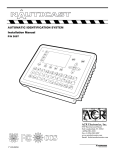
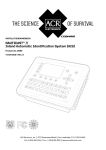
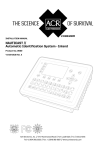
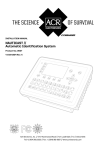



![PLAS A O ]-OR](http://vs1.manualzilla.com/store/data/005852706_1-5db0b7ed584537f0e62af161fb124638-150x150.png)
